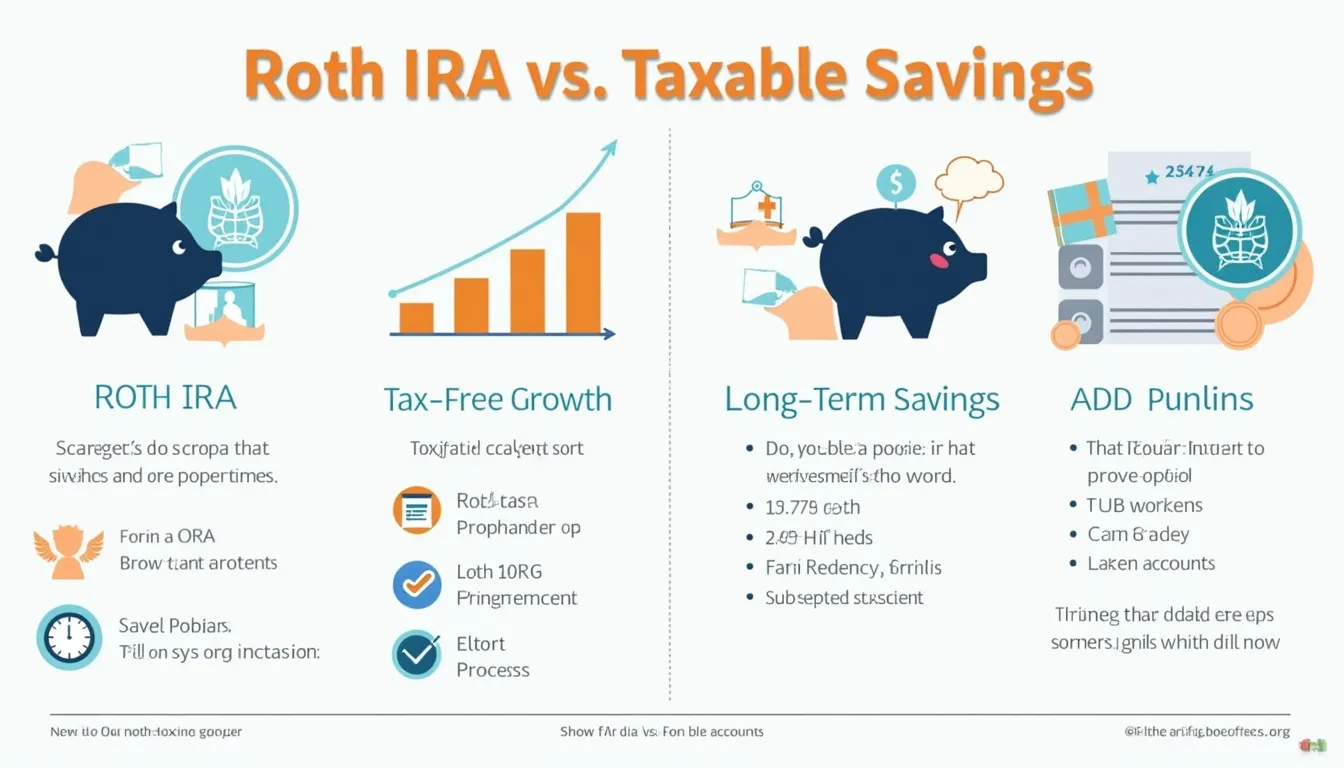Roth IRA Calculator
Is this tool helpful?
How to use the tool
Fill five fields, press Calculate, and compare projected balances:
- Initial investment ($) – starting lump sum.
Try: $4 000 or $25 500. - Annual interest rate (%) – average yearly growth before tax.
Try: 5.2 % or 7.3 %. - Investment period (years) – how long money compounds.
Try: 15 years or 40 years. - Tax rate (%) – marginal rate on investment earnings in a taxable account.
Try: 22 % or 30 %. - Annual contribution ($) – amount you add each year.
Try: $6 000 or $8 500.
Formulas used
Roth IRA grows tax-free:
$$ FV_{Roth}= P(1+r)^n + C rac{(1+r)^n-1}{r} $$Taxable account loses a slice of the return to taxes:
$$ FV_{Tax}= P\!\left(1+r(1-t)\right)^n + C rac{\left(1+r(1-t)\right)^n-1}{r(1-t)} $$- P = initial investment
- r = annual interest rate (decimal)
- n = years
- C = annual contribution
- t = tax rate (decimal)
Example 1
- P = $4 000, r = 0.052, n = 15, t = 0.22, C = $6 000
- FVRoth ≈ $140 000
- FVTax ≈ $128 000
Example 2
- P = $20 000, r = 0.073, n = 40, t = 0.30, C = $8 500
- FVRoth ≈ $2.16 million
- FVTax ≈ $1.20 million
Quick-Facts
- 2023 Roth IRA contribution limit: $6 500 (IRS, 2023).
- Early withdrawals trigger a 10 % penalty (IRS Pub 590-B, 2023).
- Average long-term U.S. stock return ≈ 7 % after inflation (Dimson et al., 2020).
- Typical long-term capital-gains tax: 15 % federal + 5 % state (Tax Foundation, 2022).
FAQ
What does the calculator show?
It projects future balances for a tax-free Roth IRA versus a taxable brokerage account so you see the cost of taxes over time.
Why does the Roth IRA usually win?
Because earnings compound free of federal tax, every year’s gain keeps working for you; the taxable account loses growth to annual tax drag (Morningstar, 2021).
Where do the interest-rate numbers come from?
Use your own estimate; historical U.S. stock returns averaged 10 % nominal, 7 % real since 1926 (Ibbotson SBBI Yearbook, 2023).
Can I model a traditional IRA?
Yes—enter your expected retirement tax rate for Tax rate (%) because traditional IRA withdrawals are taxable.
How often should I revisit the inputs?
Update at least annually or after income, market, or tax-law changes to keep projections relevant (FINRA, 2023).
What if my state taxes differ?
Add your state rate to the federal rate; the tool assumes one blended percentage.
Does the calculator include fees?
No. Subtract your fund expense ratio from the interest rate for more realistic results (SEC Investor Bulletin, 2022).
Is the 6 % annual return realistic?
For a 60/40 stock-bond mix, analysts forecast 4-6 % real returns over the next decade (J.P. Morgan GTM, 2024).
Important Disclaimer
The calculations, results, and content provided by our tools are not guaranteed to be accurate, complete, or reliable. Users are responsible for verifying and interpreting the results. Our content and tools may contain errors, biases, or inconsistencies. Do not enter personal data, sensitive information, or personally identifiable information in our web forms or tools. Such data entry violates our terms of service and may result in unauthorized disclosure to third parties. We reserve the right to save inputs and outputs from our tools for the purposes of error debugging, bias identification, and performance improvement. External companies providing AI models used in our tools may also save and process data in accordance with their own policies. By using our tools, you consent to this data collection and processing. We reserve the right to limit the usage of our tools based on current usability factors.







